Effective Health Education by Nurses for Diabetes Management
VerifiedAdded on 2023/06/10
|10
|2592
|242
Report
AI Summary
This report explores the effectiveness of health education provided by nurses to diabetic patients for self-management post-discharge. It aims to understand the motivational elements in patient education, identify loopholes in diabetes education, and assess patient competency in managing their condition. The research question focuses on whether patients can effectively manage diabetes with proper health education before discharge. A literature review examines existing studies on self-management programs and educational interventions, highlighting the importance of prior knowledge. The proposed research design employs a quantitative approach, using a survey of 100 diabetic patients to assess the impact of nursing health education on diabetes management, data will be analyzed using STATA software, and ethical considerations, including informed consent and data confidentiality, are addressed to ensure the integrity of the study. Desklib offers this report, along with numerous other resources, to aid students in their studies.
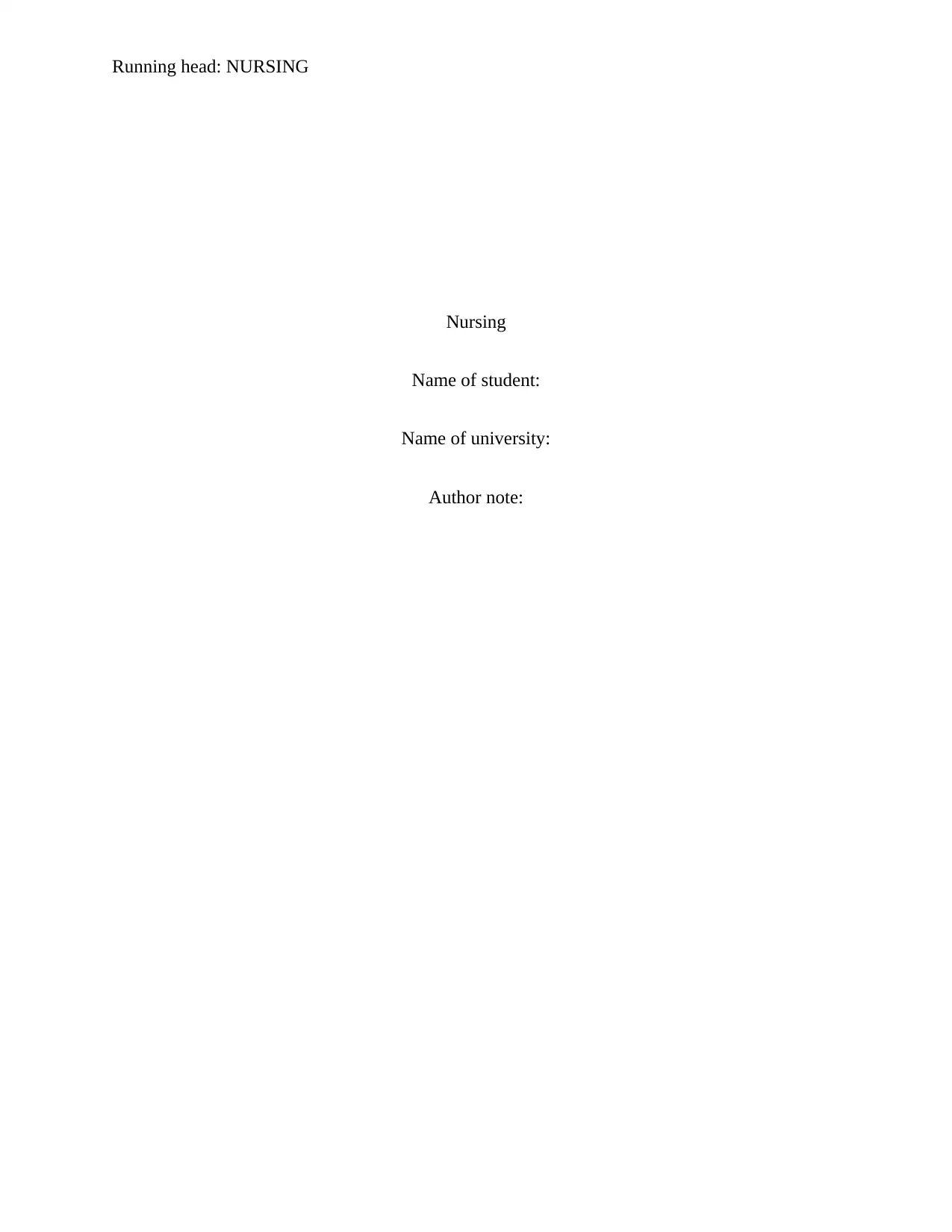
Running head: NURSING
Nursing
Name of student:
Name of university:
Author note:
Nursing
Name of student:
Name of university:
Author note:
Paraphrase This Document
Need a fresh take? Get an instant paraphrase of this document with our AI Paraphraser
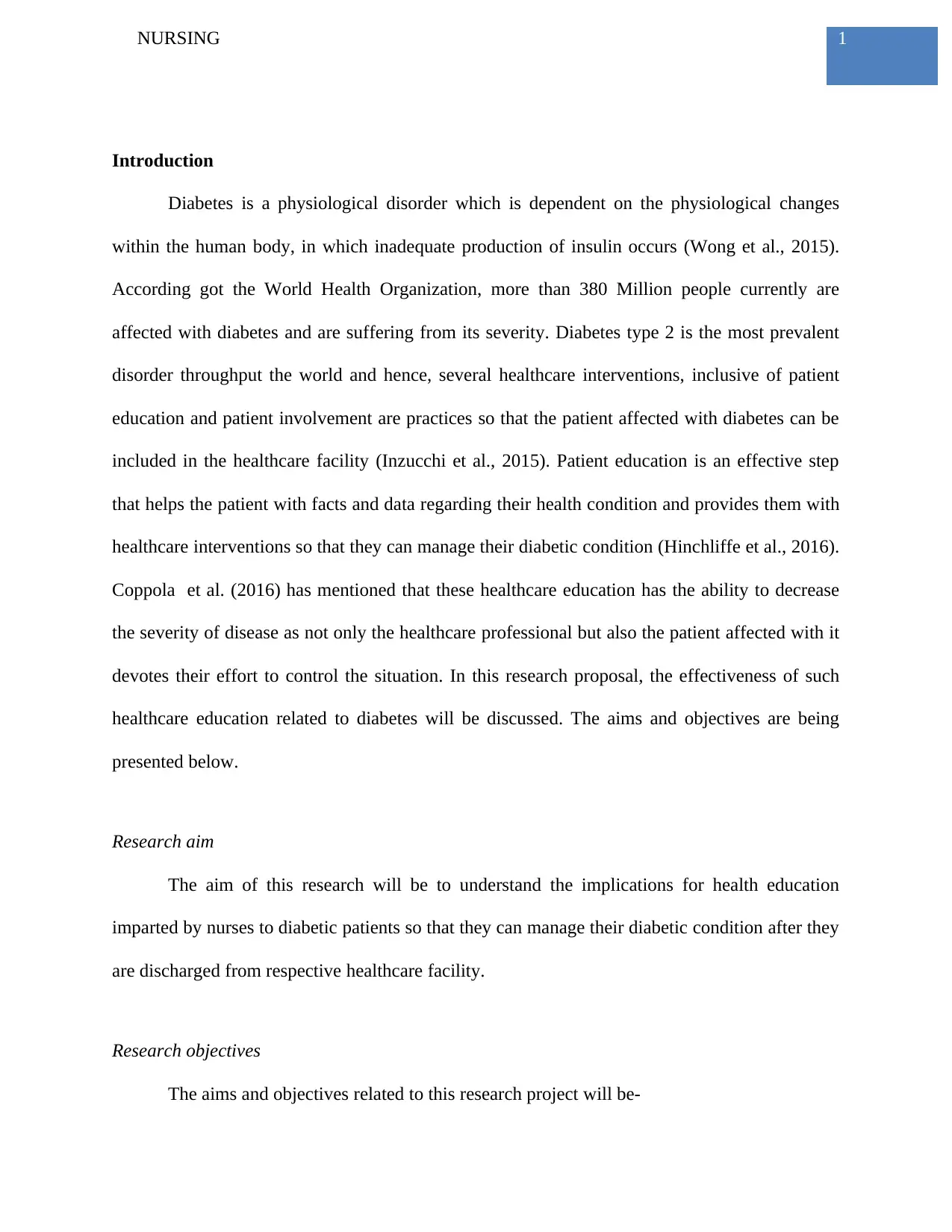
1NURSING
Introduction
Diabetes is a physiological disorder which is dependent on the physiological changes
within the human body, in which inadequate production of insulin occurs (Wong et al., 2015).
According got the World Health Organization, more than 380 Million people currently are
affected with diabetes and are suffering from its severity. Diabetes type 2 is the most prevalent
disorder throughput the world and hence, several healthcare interventions, inclusive of patient
education and patient involvement are practices so that the patient affected with diabetes can be
included in the healthcare facility (Inzucchi et al., 2015). Patient education is an effective step
that helps the patient with facts and data regarding their health condition and provides them with
healthcare interventions so that they can manage their diabetic condition (Hinchliffe et al., 2016).
Coppola et al. (2016) has mentioned that these healthcare education has the ability to decrease
the severity of disease as not only the healthcare professional but also the patient affected with it
devotes their effort to control the situation. In this research proposal, the effectiveness of such
healthcare education related to diabetes will be discussed. The aims and objectives are being
presented below.
Research aim
The aim of this research will be to understand the implications for health education
imparted by nurses to diabetic patients so that they can manage their diabetic condition after they
are discharged from respective healthcare facility.
Research objectives
The aims and objectives related to this research project will be-
Introduction
Diabetes is a physiological disorder which is dependent on the physiological changes
within the human body, in which inadequate production of insulin occurs (Wong et al., 2015).
According got the World Health Organization, more than 380 Million people currently are
affected with diabetes and are suffering from its severity. Diabetes type 2 is the most prevalent
disorder throughput the world and hence, several healthcare interventions, inclusive of patient
education and patient involvement are practices so that the patient affected with diabetes can be
included in the healthcare facility (Inzucchi et al., 2015). Patient education is an effective step
that helps the patient with facts and data regarding their health condition and provides them with
healthcare interventions so that they can manage their diabetic condition (Hinchliffe et al., 2016).
Coppola et al. (2016) has mentioned that these healthcare education has the ability to decrease
the severity of disease as not only the healthcare professional but also the patient affected with it
devotes their effort to control the situation. In this research proposal, the effectiveness of such
healthcare education related to diabetes will be discussed. The aims and objectives are being
presented below.
Research aim
The aim of this research will be to understand the implications for health education
imparted by nurses to diabetic patients so that they can manage their diabetic condition after they
are discharged from respective healthcare facility.
Research objectives
The aims and objectives related to this research project will be-
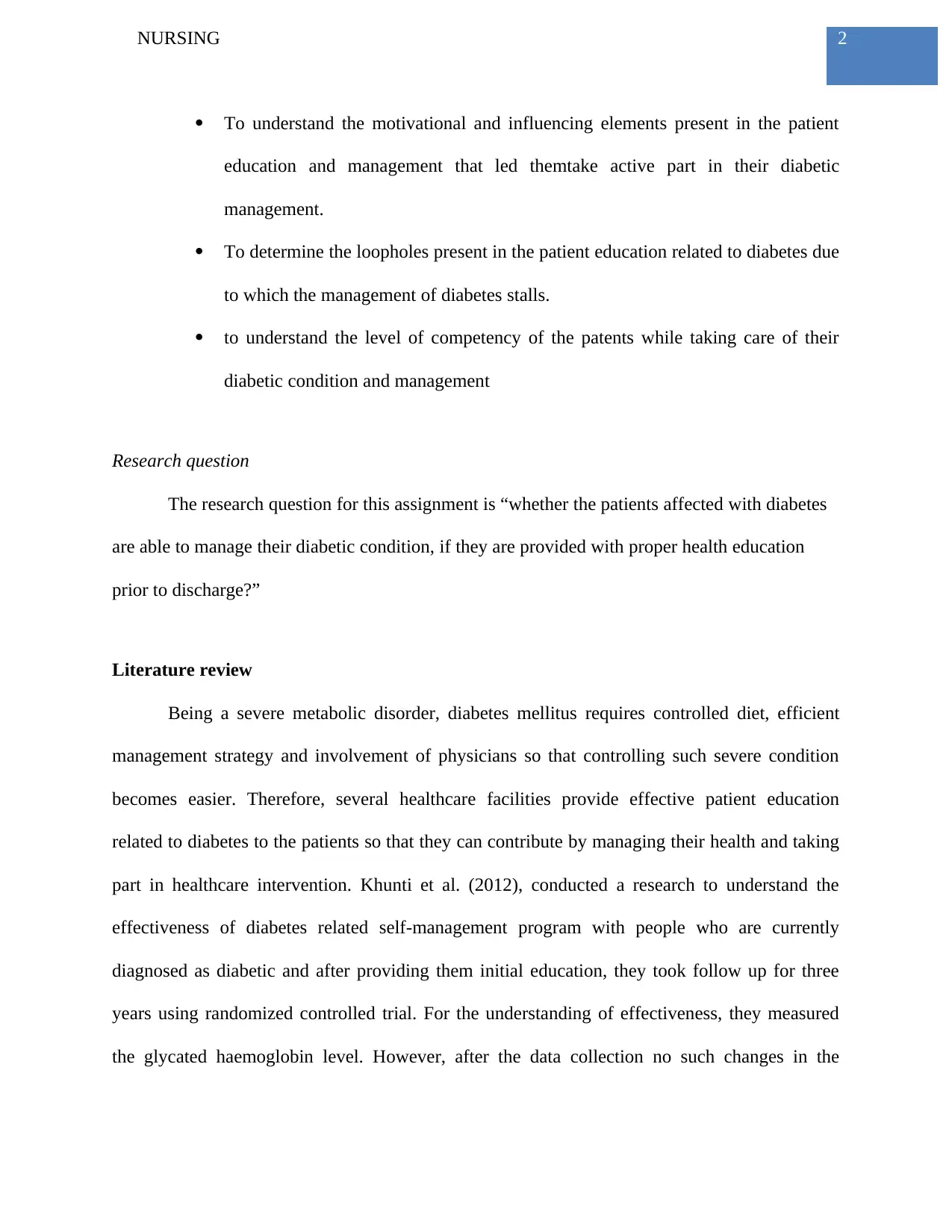
2NURSING
To understand the motivational and influencing elements present in the patient
education and management that led themtake active part in their diabetic
management.
To determine the loopholes present in the patient education related to diabetes due
to which the management of diabetes stalls.
to understand the level of competency of the patents while taking care of their
diabetic condition and management
Research question
The research question for this assignment is “whether the patients affected with diabetes
are able to manage their diabetic condition, if they are provided with proper health education
prior to discharge?”
Literature review
Being a severe metabolic disorder, diabetes mellitus requires controlled diet, efficient
management strategy and involvement of physicians so that controlling such severe condition
becomes easier. Therefore, several healthcare facilities provide effective patient education
related to diabetes to the patients so that they can contribute by managing their health and taking
part in healthcare intervention. Khunti et al. (2012), conducted a research to understand the
effectiveness of diabetes related self-management program with people who are currently
diagnosed as diabetic and after providing them initial education, they took follow up for three
years using randomized controlled trial. For the understanding of effectiveness, they measured
the glycated haemoglobin level. However, after the data collection no such changes in the
To understand the motivational and influencing elements present in the patient
education and management that led themtake active part in their diabetic
management.
To determine the loopholes present in the patient education related to diabetes due
to which the management of diabetes stalls.
to understand the level of competency of the patents while taking care of their
diabetic condition and management
Research question
The research question for this assignment is “whether the patients affected with diabetes
are able to manage their diabetic condition, if they are provided with proper health education
prior to discharge?”
Literature review
Being a severe metabolic disorder, diabetes mellitus requires controlled diet, efficient
management strategy and involvement of physicians so that controlling such severe condition
becomes easier. Therefore, several healthcare facilities provide effective patient education
related to diabetes to the patients so that they can contribute by managing their health and taking
part in healthcare intervention. Khunti et al. (2012), conducted a research to understand the
effectiveness of diabetes related self-management program with people who are currently
diagnosed as diabetic and after providing them initial education, they took follow up for three
years using randomized controlled trial. For the understanding of effectiveness, they measured
the glycated haemoglobin level. However, after the data collection no such changes in the
⊘ This is a preview!⊘
Do you want full access?
Subscribe today to unlock all pages.

Trusted by 1+ million students worldwide
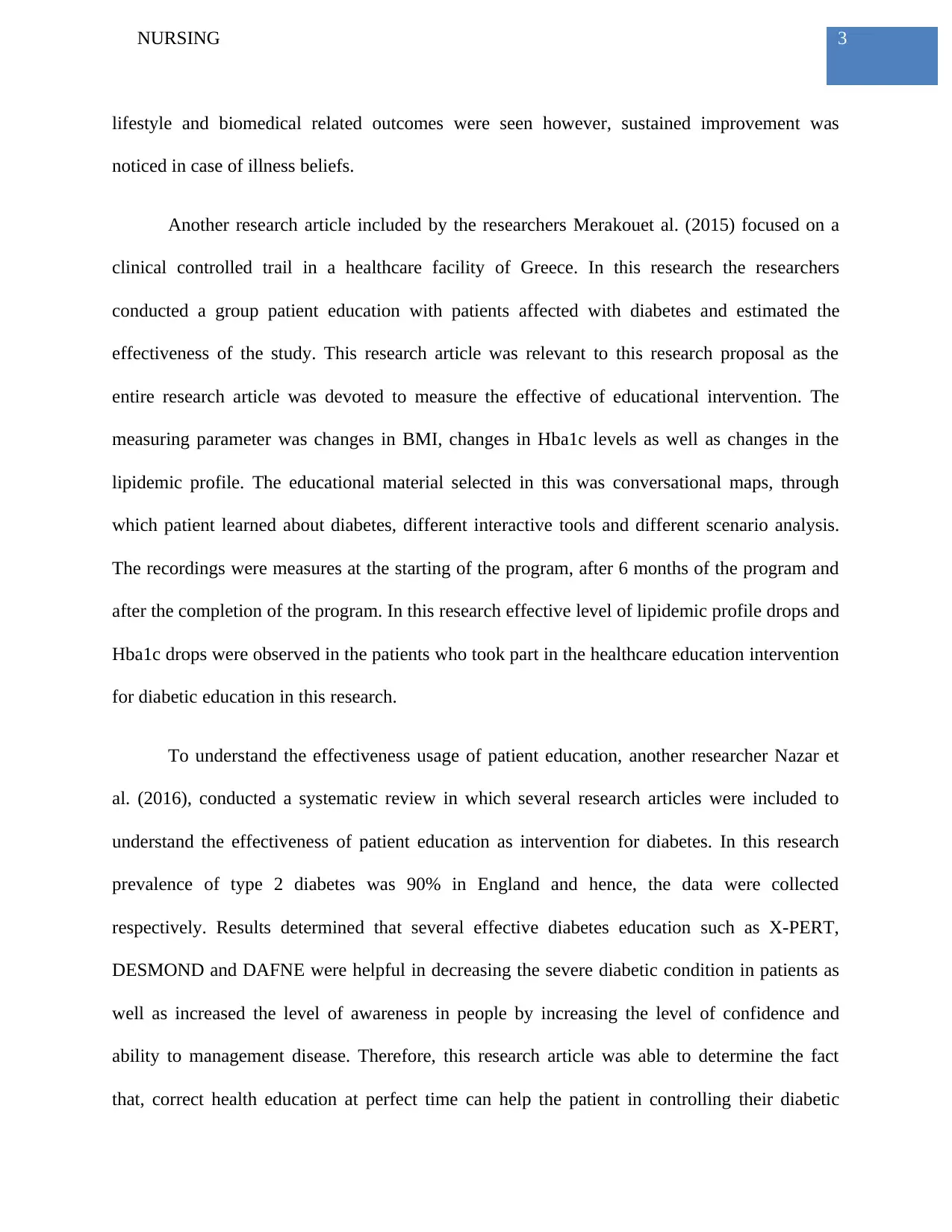
3NURSING
lifestyle and biomedical related outcomes were seen however, sustained improvement was
noticed in case of illness beliefs.
Another research article included by the researchers Merakouet al. (2015) focused on a
clinical controlled trail in a healthcare facility of Greece. In this research the researchers
conducted a group patient education with patients affected with diabetes and estimated the
effectiveness of the study. This research article was relevant to this research proposal as the
entire research article was devoted to measure the effective of educational intervention. The
measuring parameter was changes in BMI, changes in Hba1c levels as well as changes in the
lipidemic profile. The educational material selected in this was conversational maps, through
which patient learned about diabetes, different interactive tools and different scenario analysis.
The recordings were measures at the starting of the program, after 6 months of the program and
after the completion of the program. In this research effective level of lipidemic profile drops and
Hba1c drops were observed in the patients who took part in the healthcare education intervention
for diabetic education in this research.
To understand the effectiveness usage of patient education, another researcher Nazar et
al. (2016), conducted a systematic review in which several research articles were included to
understand the effectiveness of patient education as intervention for diabetes. In this research
prevalence of type 2 diabetes was 90% in England and hence, the data were collected
respectively. Results determined that several effective diabetes education such as X-PERT,
DESMOND and DAFNE were helpful in decreasing the severe diabetic condition in patients as
well as increased the level of awareness in people by increasing the level of confidence and
ability to management disease. Therefore, this research article was able to determine the fact
that, correct health education at perfect time can help the patient in controlling their diabetic
lifestyle and biomedical related outcomes were seen however, sustained improvement was
noticed in case of illness beliefs.
Another research article included by the researchers Merakouet al. (2015) focused on a
clinical controlled trail in a healthcare facility of Greece. In this research the researchers
conducted a group patient education with patients affected with diabetes and estimated the
effectiveness of the study. This research article was relevant to this research proposal as the
entire research article was devoted to measure the effective of educational intervention. The
measuring parameter was changes in BMI, changes in Hba1c levels as well as changes in the
lipidemic profile. The educational material selected in this was conversational maps, through
which patient learned about diabetes, different interactive tools and different scenario analysis.
The recordings were measures at the starting of the program, after 6 months of the program and
after the completion of the program. In this research effective level of lipidemic profile drops and
Hba1c drops were observed in the patients who took part in the healthcare education intervention
for diabetic education in this research.
To understand the effectiveness usage of patient education, another researcher Nazar et
al. (2016), conducted a systematic review in which several research articles were included to
understand the effectiveness of patient education as intervention for diabetes. In this research
prevalence of type 2 diabetes was 90% in England and hence, the data were collected
respectively. Results determined that several effective diabetes education such as X-PERT,
DESMOND and DAFNE were helpful in decreasing the severe diabetic condition in patients as
well as increased the level of awareness in people by increasing the level of confidence and
ability to management disease. Therefore, this research article was able to determine the fact
that, correct health education at perfect time can help the patient in controlling their diabetic
Paraphrase This Document
Need a fresh take? Get an instant paraphrase of this document with our AI Paraphraser
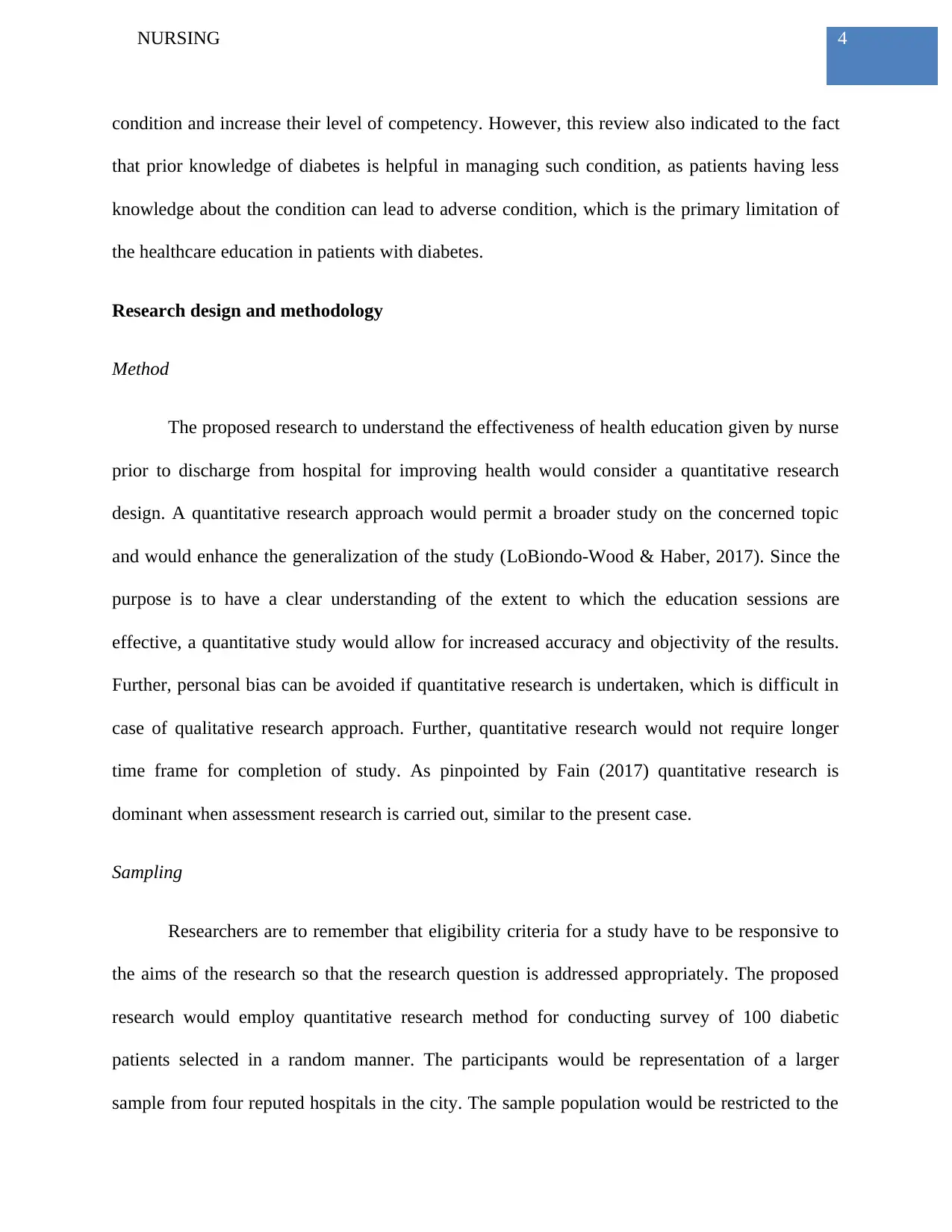
4NURSING
condition and increase their level of competency. However, this review also indicated to the fact
that prior knowledge of diabetes is helpful in managing such condition, as patients having less
knowledge about the condition can lead to adverse condition, which is the primary limitation of
the healthcare education in patients with diabetes.
Research design and methodology
Method
The proposed research to understand the effectiveness of health education given by nurse
prior to discharge from hospital for improving health would consider a quantitative research
design. A quantitative research approach would permit a broader study on the concerned topic
and would enhance the generalization of the study (LoBiondo-Wood & Haber, 2017). Since the
purpose is to have a clear understanding of the extent to which the education sessions are
effective, a quantitative study would allow for increased accuracy and objectivity of the results.
Further, personal bias can be avoided if quantitative research is undertaken, which is difficult in
case of qualitative research approach. Further, quantitative research would not require longer
time frame for completion of study. As pinpointed by Fain (2017) quantitative research is
dominant when assessment research is carried out, similar to the present case.
Sampling
Researchers are to remember that eligibility criteria for a study have to be responsive to
the aims of the research so that the research question is addressed appropriately. The proposed
research would employ quantitative research method for conducting survey of 100 diabetic
patients selected in a random manner. The participants would be representation of a larger
sample from four reputed hospitals in the city. The sample population would be restricted to the
condition and increase their level of competency. However, this review also indicated to the fact
that prior knowledge of diabetes is helpful in managing such condition, as patients having less
knowledge about the condition can lead to adverse condition, which is the primary limitation of
the healthcare education in patients with diabetes.
Research design and methodology
Method
The proposed research to understand the effectiveness of health education given by nurse
prior to discharge from hospital for improving health would consider a quantitative research
design. A quantitative research approach would permit a broader study on the concerned topic
and would enhance the generalization of the study (LoBiondo-Wood & Haber, 2017). Since the
purpose is to have a clear understanding of the extent to which the education sessions are
effective, a quantitative study would allow for increased accuracy and objectivity of the results.
Further, personal bias can be avoided if quantitative research is undertaken, which is difficult in
case of qualitative research approach. Further, quantitative research would not require longer
time frame for completion of study. As pinpointed by Fain (2017) quantitative research is
dominant when assessment research is carried out, similar to the present case.
Sampling
Researchers are to remember that eligibility criteria for a study have to be responsive to
the aims of the research so that the research question is addressed appropriately. The proposed
research would employ quantitative research method for conducting survey of 100 diabetic
patients selected in a random manner. The participants would be representation of a larger
sample from four reputed hospitals in the city. The sample population would be restricted to the
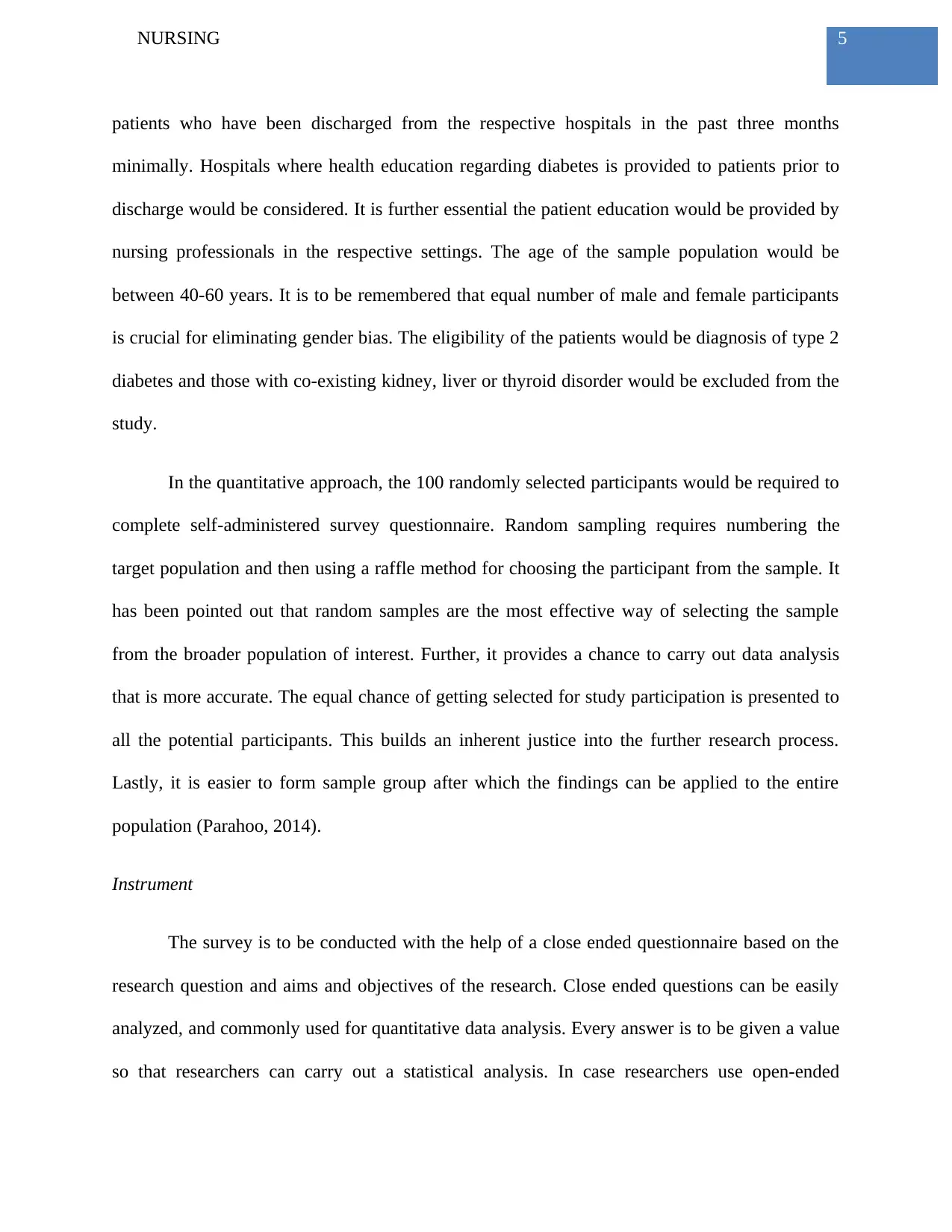
5NURSING
patients who have been discharged from the respective hospitals in the past three months
minimally. Hospitals where health education regarding diabetes is provided to patients prior to
discharge would be considered. It is further essential the patient education would be provided by
nursing professionals in the respective settings. The age of the sample population would be
between 40-60 years. It is to be remembered that equal number of male and female participants
is crucial for eliminating gender bias. The eligibility of the patients would be diagnosis of type 2
diabetes and those with co-existing kidney, liver or thyroid disorder would be excluded from the
study.
In the quantitative approach, the 100 randomly selected participants would be required to
complete self-administered survey questionnaire. Random sampling requires numbering the
target population and then using a raffle method for choosing the participant from the sample. It
has been pointed out that random samples are the most effective way of selecting the sample
from the broader population of interest. Further, it provides a chance to carry out data analysis
that is more accurate. The equal chance of getting selected for study participation is presented to
all the potential participants. This builds an inherent justice into the further research process.
Lastly, it is easier to form sample group after which the findings can be applied to the entire
population (Parahoo, 2014).
Instrument
The survey is to be conducted with the help of a close ended questionnaire based on the
research question and aims and objectives of the research. Close ended questions can be easily
analyzed, and commonly used for quantitative data analysis. Every answer is to be given a value
so that researchers can carry out a statistical analysis. In case researchers use open-ended
patients who have been discharged from the respective hospitals in the past three months
minimally. Hospitals where health education regarding diabetes is provided to patients prior to
discharge would be considered. It is further essential the patient education would be provided by
nursing professionals in the respective settings. The age of the sample population would be
between 40-60 years. It is to be remembered that equal number of male and female participants
is crucial for eliminating gender bias. The eligibility of the patients would be diagnosis of type 2
diabetes and those with co-existing kidney, liver or thyroid disorder would be excluded from the
study.
In the quantitative approach, the 100 randomly selected participants would be required to
complete self-administered survey questionnaire. Random sampling requires numbering the
target population and then using a raffle method for choosing the participant from the sample. It
has been pointed out that random samples are the most effective way of selecting the sample
from the broader population of interest. Further, it provides a chance to carry out data analysis
that is more accurate. The equal chance of getting selected for study participation is presented to
all the potential participants. This builds an inherent justice into the further research process.
Lastly, it is easier to form sample group after which the findings can be applied to the entire
population (Parahoo, 2014).
Instrument
The survey is to be conducted with the help of a close ended questionnaire based on the
research question and aims and objectives of the research. Close ended questions can be easily
analyzed, and commonly used for quantitative data analysis. Every answer is to be given a value
so that researchers can carry out a statistical analysis. In case researchers use open-ended
⊘ This is a preview!⊘
Do you want full access?
Subscribe today to unlock all pages.

Trusted by 1+ million students worldwide
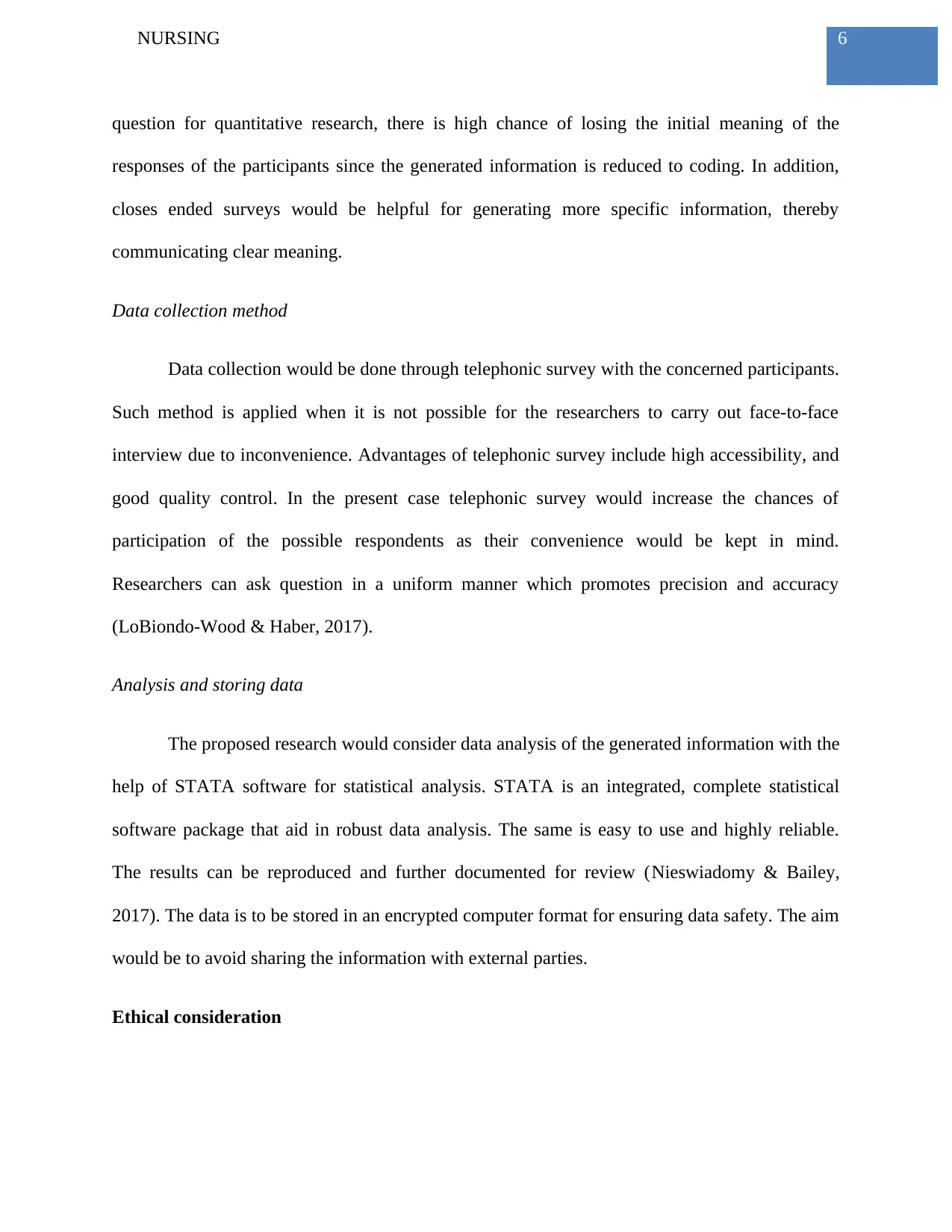
6NURSING
question for quantitative research, there is high chance of losing the initial meaning of the
responses of the participants since the generated information is reduced to coding. In addition,
closes ended surveys would be helpful for generating more specific information, thereby
communicating clear meaning.
Data collection method
Data collection would be done through telephonic survey with the concerned participants.
Such method is applied when it is not possible for the researchers to carry out face-to-face
interview due to inconvenience. Advantages of telephonic survey include high accessibility, and
good quality control. In the present case telephonic survey would increase the chances of
participation of the possible respondents as their convenience would be kept in mind.
Researchers can ask question in a uniform manner which promotes precision and accuracy
(LoBiondo-Wood & Haber, 2017).
Analysis and storing data
The proposed research would consider data analysis of the generated information with the
help of STATA software for statistical analysis. STATA is an integrated, complete statistical
software package that aid in robust data analysis. The same is easy to use and highly reliable.
The results can be reproduced and further documented for review (Nieswiadomy & Bailey,
2017). The data is to be stored in an encrypted computer format for ensuring data safety. The aim
would be to avoid sharing the information with external parties.
Ethical consideration
question for quantitative research, there is high chance of losing the initial meaning of the
responses of the participants since the generated information is reduced to coding. In addition,
closes ended surveys would be helpful for generating more specific information, thereby
communicating clear meaning.
Data collection method
Data collection would be done through telephonic survey with the concerned participants.
Such method is applied when it is not possible for the researchers to carry out face-to-face
interview due to inconvenience. Advantages of telephonic survey include high accessibility, and
good quality control. In the present case telephonic survey would increase the chances of
participation of the possible respondents as their convenience would be kept in mind.
Researchers can ask question in a uniform manner which promotes precision and accuracy
(LoBiondo-Wood & Haber, 2017).
Analysis and storing data
The proposed research would consider data analysis of the generated information with the
help of STATA software for statistical analysis. STATA is an integrated, complete statistical
software package that aid in robust data analysis. The same is easy to use and highly reliable.
The results can be reproduced and further documented for review (Nieswiadomy & Bailey,
2017). The data is to be stored in an encrypted computer format for ensuring data safety. The aim
would be to avoid sharing the information with external parties.
Ethical consideration
Paraphrase This Document
Need a fresh take? Get an instant paraphrase of this document with our AI Paraphraser
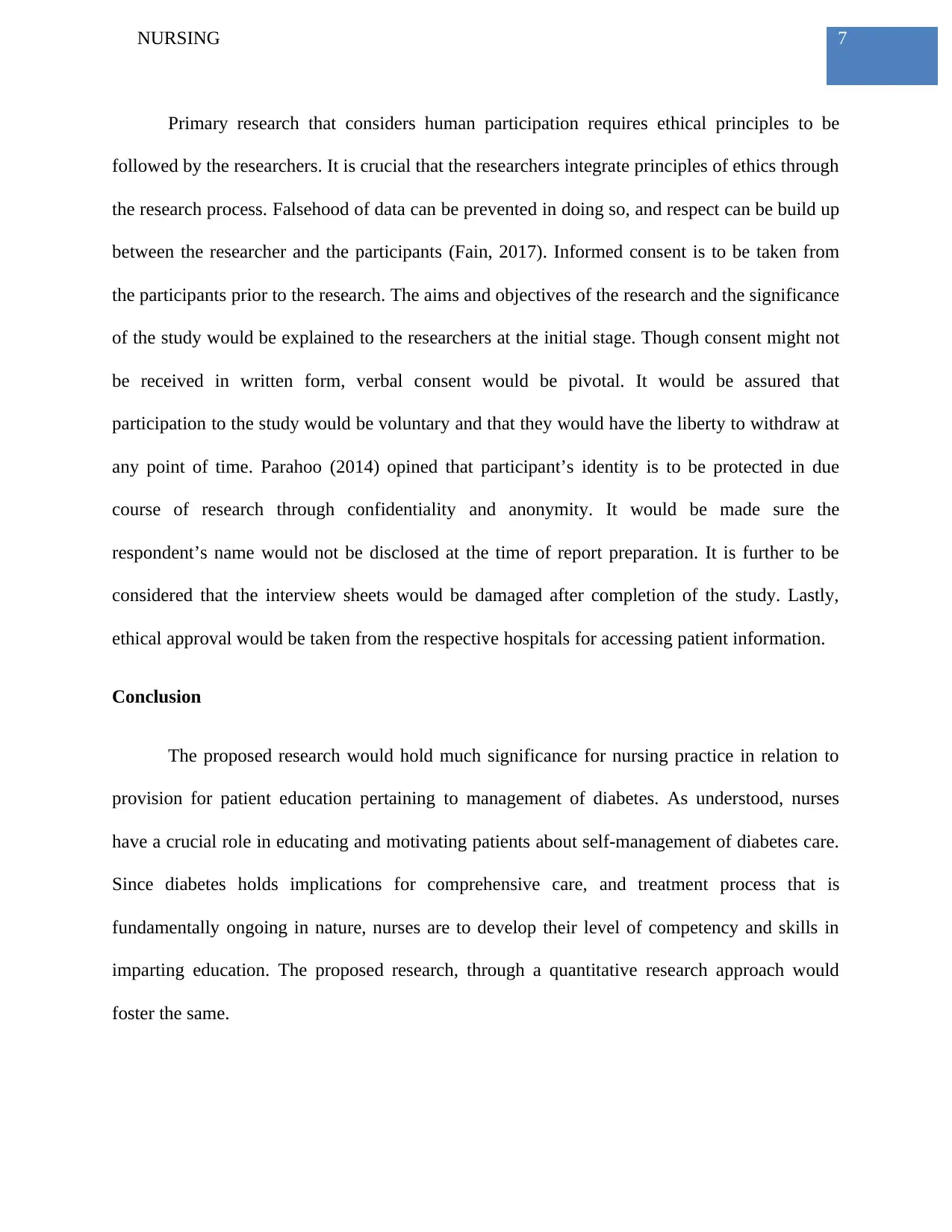
7NURSING
Primary research that considers human participation requires ethical principles to be
followed by the researchers. It is crucial that the researchers integrate principles of ethics through
the research process. Falsehood of data can be prevented in doing so, and respect can be build up
between the researcher and the participants (Fain, 2017). Informed consent is to be taken from
the participants prior to the research. The aims and objectives of the research and the significance
of the study would be explained to the researchers at the initial stage. Though consent might not
be received in written form, verbal consent would be pivotal. It would be assured that
participation to the study would be voluntary and that they would have the liberty to withdraw at
any point of time. Parahoo (2014) opined that participant’s identity is to be protected in due
course of research through confidentiality and anonymity. It would be made sure the
respondent’s name would not be disclosed at the time of report preparation. It is further to be
considered that the interview sheets would be damaged after completion of the study. Lastly,
ethical approval would be taken from the respective hospitals for accessing patient information.
Conclusion
The proposed research would hold much significance for nursing practice in relation to
provision for patient education pertaining to management of diabetes. As understood, nurses
have a crucial role in educating and motivating patients about self-management of diabetes care.
Since diabetes holds implications for comprehensive care, and treatment process that is
fundamentally ongoing in nature, nurses are to develop their level of competency and skills in
imparting education. The proposed research, through a quantitative research approach would
foster the same.
Primary research that considers human participation requires ethical principles to be
followed by the researchers. It is crucial that the researchers integrate principles of ethics through
the research process. Falsehood of data can be prevented in doing so, and respect can be build up
between the researcher and the participants (Fain, 2017). Informed consent is to be taken from
the participants prior to the research. The aims and objectives of the research and the significance
of the study would be explained to the researchers at the initial stage. Though consent might not
be received in written form, verbal consent would be pivotal. It would be assured that
participation to the study would be voluntary and that they would have the liberty to withdraw at
any point of time. Parahoo (2014) opined that participant’s identity is to be protected in due
course of research through confidentiality and anonymity. It would be made sure the
respondent’s name would not be disclosed at the time of report preparation. It is further to be
considered that the interview sheets would be damaged after completion of the study. Lastly,
ethical approval would be taken from the respective hospitals for accessing patient information.
Conclusion
The proposed research would hold much significance for nursing practice in relation to
provision for patient education pertaining to management of diabetes. As understood, nurses
have a crucial role in educating and motivating patients about self-management of diabetes care.
Since diabetes holds implications for comprehensive care, and treatment process that is
fundamentally ongoing in nature, nurses are to develop their level of competency and skills in
imparting education. The proposed research, through a quantitative research approach would
foster the same.
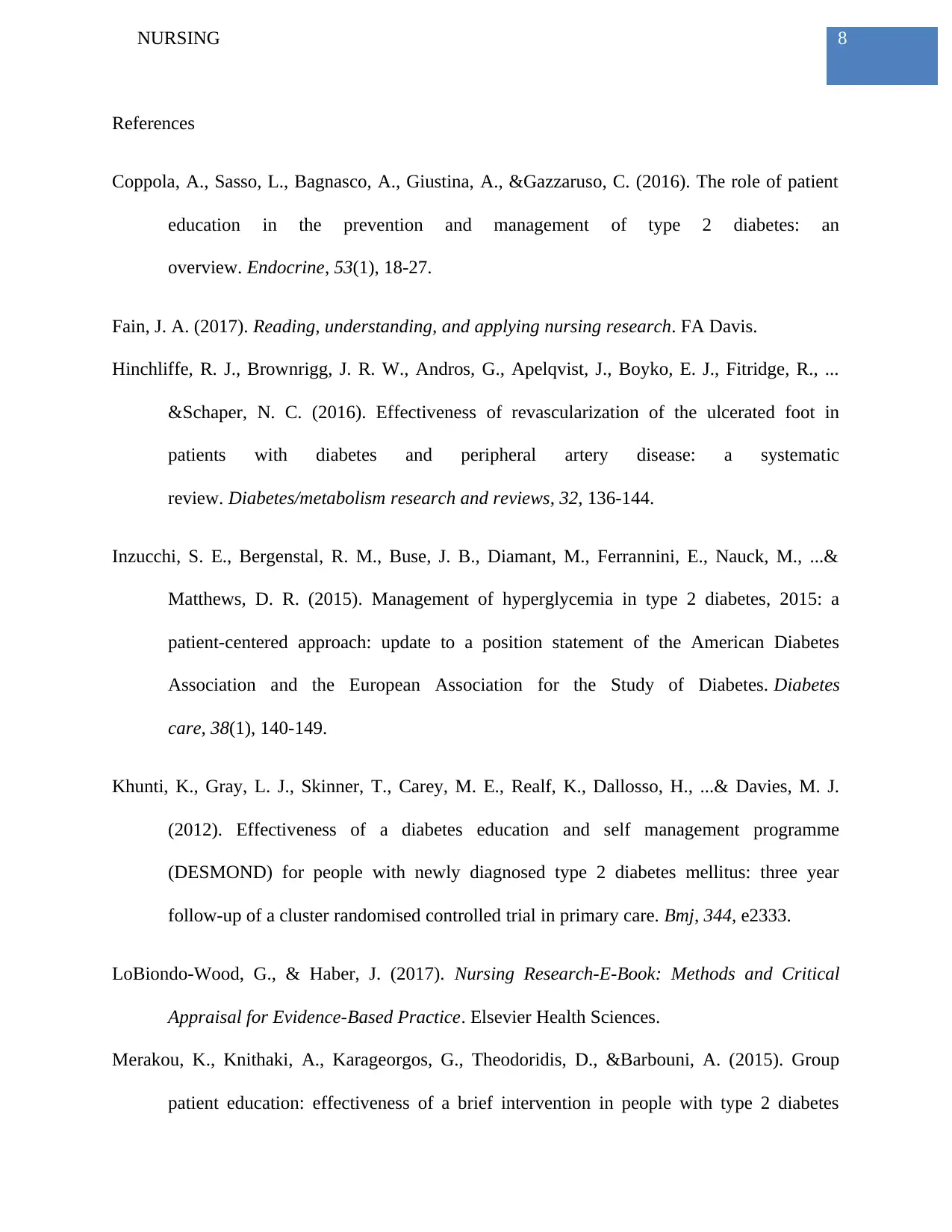
8NURSING
References
Coppola, A., Sasso, L., Bagnasco, A., Giustina, A., &Gazzaruso, C. (2016). The role of patient
education in the prevention and management of type 2 diabetes: an
overview. Endocrine, 53(1), 18-27.
Fain, J. A. (2017). Reading, understanding, and applying nursing research. FA Davis.
Hinchliffe, R. J., Brownrigg, J. R. W., Andros, G., Apelqvist, J., Boyko, E. J., Fitridge, R., ...
&Schaper, N. C. (2016). Effectiveness of revascularization of the ulcerated foot in
patients with diabetes and peripheral artery disease: a systematic
review. Diabetes/metabolism research and reviews, 32, 136-144.
Inzucchi, S. E., Bergenstal, R. M., Buse, J. B., Diamant, M., Ferrannini, E., Nauck, M., ...&
Matthews, D. R. (2015). Management of hyperglycemia in type 2 diabetes, 2015: a
patient-centered approach: update to a position statement of the American Diabetes
Association and the European Association for the Study of Diabetes. Diabetes
care, 38(1), 140-149.
Khunti, K., Gray, L. J., Skinner, T., Carey, M. E., Realf, K., Dallosso, H., ...& Davies, M. J.
(2012). Effectiveness of a diabetes education and self management programme
(DESMOND) for people with newly diagnosed type 2 diabetes mellitus: three year
follow-up of a cluster randomised controlled trial in primary care. Bmj, 344, e2333.
LoBiondo-Wood, G., & Haber, J. (2017). Nursing Research-E-Book: Methods and Critical
Appraisal for Evidence-Based Practice. Elsevier Health Sciences.
Merakou, K., Knithaki, A., Karageorgos, G., Theodoridis, D., &Barbouni, A. (2015). Group
patient education: effectiveness of a brief intervention in people with type 2 diabetes
References
Coppola, A., Sasso, L., Bagnasco, A., Giustina, A., &Gazzaruso, C. (2016). The role of patient
education in the prevention and management of type 2 diabetes: an
overview. Endocrine, 53(1), 18-27.
Fain, J. A. (2017). Reading, understanding, and applying nursing research. FA Davis.
Hinchliffe, R. J., Brownrigg, J. R. W., Andros, G., Apelqvist, J., Boyko, E. J., Fitridge, R., ...
&Schaper, N. C. (2016). Effectiveness of revascularization of the ulcerated foot in
patients with diabetes and peripheral artery disease: a systematic
review. Diabetes/metabolism research and reviews, 32, 136-144.
Inzucchi, S. E., Bergenstal, R. M., Buse, J. B., Diamant, M., Ferrannini, E., Nauck, M., ...&
Matthews, D. R. (2015). Management of hyperglycemia in type 2 diabetes, 2015: a
patient-centered approach: update to a position statement of the American Diabetes
Association and the European Association for the Study of Diabetes. Diabetes
care, 38(1), 140-149.
Khunti, K., Gray, L. J., Skinner, T., Carey, M. E., Realf, K., Dallosso, H., ...& Davies, M. J.
(2012). Effectiveness of a diabetes education and self management programme
(DESMOND) for people with newly diagnosed type 2 diabetes mellitus: three year
follow-up of a cluster randomised controlled trial in primary care. Bmj, 344, e2333.
LoBiondo-Wood, G., & Haber, J. (2017). Nursing Research-E-Book: Methods and Critical
Appraisal for Evidence-Based Practice. Elsevier Health Sciences.
Merakou, K., Knithaki, A., Karageorgos, G., Theodoridis, D., &Barbouni, A. (2015). Group
patient education: effectiveness of a brief intervention in people with type 2 diabetes
⊘ This is a preview!⊘
Do you want full access?
Subscribe today to unlock all pages.

Trusted by 1+ million students worldwide
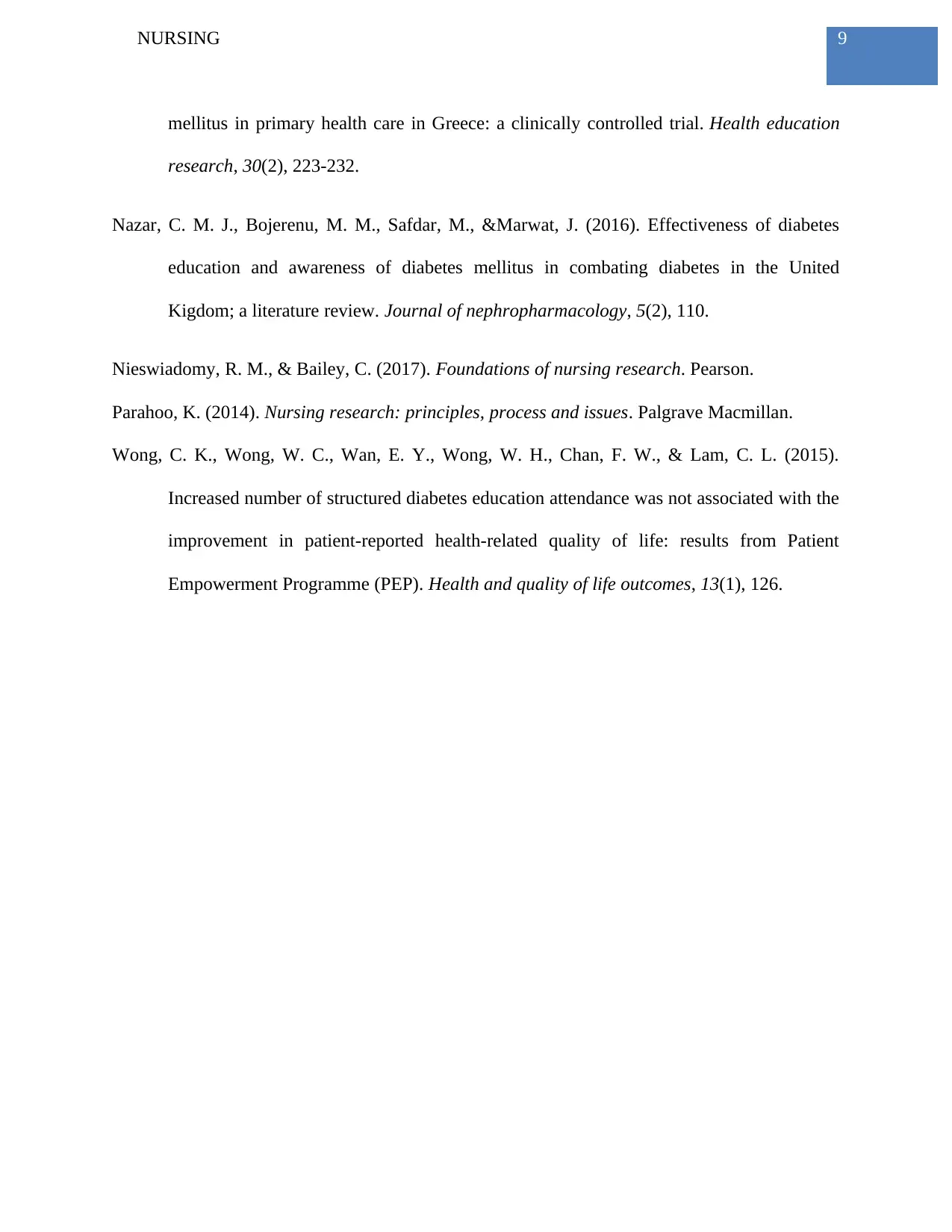
9NURSING
mellitus in primary health care in Greece: a clinically controlled trial. Health education
research, 30(2), 223-232.
Nazar, C. M. J., Bojerenu, M. M., Safdar, M., &Marwat, J. (2016). Effectiveness of diabetes
education and awareness of diabetes mellitus in combating diabetes in the United
Kigdom; a literature review. Journal of nephropharmacology, 5(2), 110.
Nieswiadomy, R. M., & Bailey, C. (2017). Foundations of nursing research. Pearson.
Parahoo, K. (2014). Nursing research: principles, process and issues. Palgrave Macmillan.
Wong, C. K., Wong, W. C., Wan, E. Y., Wong, W. H., Chan, F. W., & Lam, C. L. (2015).
Increased number of structured diabetes education attendance was not associated with the
improvement in patient-reported health-related quality of life: results from Patient
Empowerment Programme (PEP). Health and quality of life outcomes, 13(1), 126.
mellitus in primary health care in Greece: a clinically controlled trial. Health education
research, 30(2), 223-232.
Nazar, C. M. J., Bojerenu, M. M., Safdar, M., &Marwat, J. (2016). Effectiveness of diabetes
education and awareness of diabetes mellitus in combating diabetes in the United
Kigdom; a literature review. Journal of nephropharmacology, 5(2), 110.
Nieswiadomy, R. M., & Bailey, C. (2017). Foundations of nursing research. Pearson.
Parahoo, K. (2014). Nursing research: principles, process and issues. Palgrave Macmillan.
Wong, C. K., Wong, W. C., Wan, E. Y., Wong, W. H., Chan, F. W., & Lam, C. L. (2015).
Increased number of structured diabetes education attendance was not associated with the
improvement in patient-reported health-related quality of life: results from Patient
Empowerment Programme (PEP). Health and quality of life outcomes, 13(1), 126.
1 out of 10
Related Documents
Your All-in-One AI-Powered Toolkit for Academic Success.
+13062052269
info@desklib.com
Available 24*7 on WhatsApp / Email
![[object Object]](/_next/static/media/star-bottom.7253800d.svg)
Unlock your academic potential
Copyright © 2020–2025 A2Z Services. All Rights Reserved. Developed and managed by ZUCOL.





